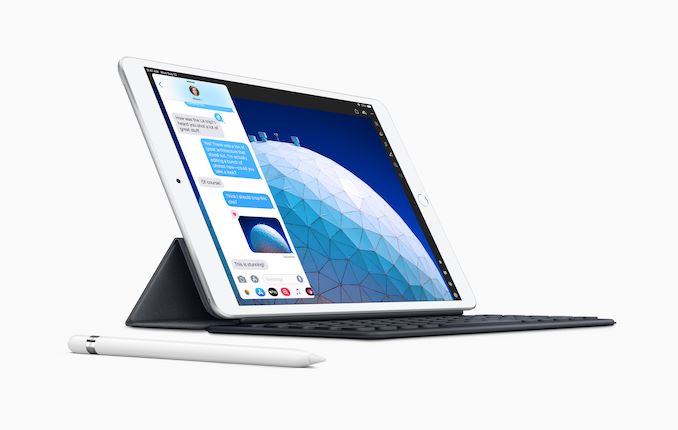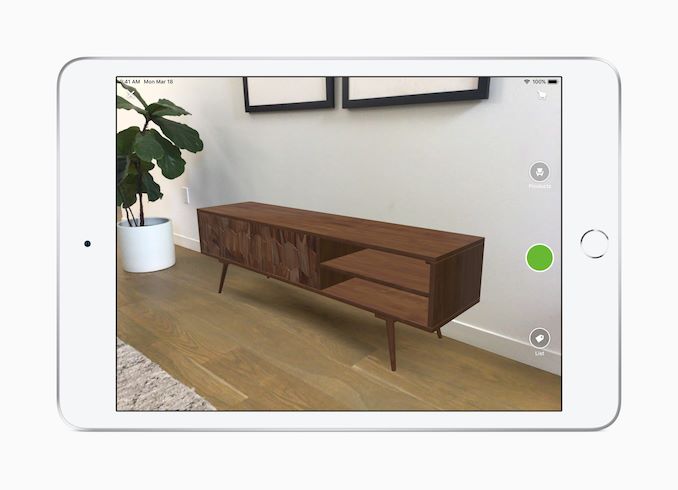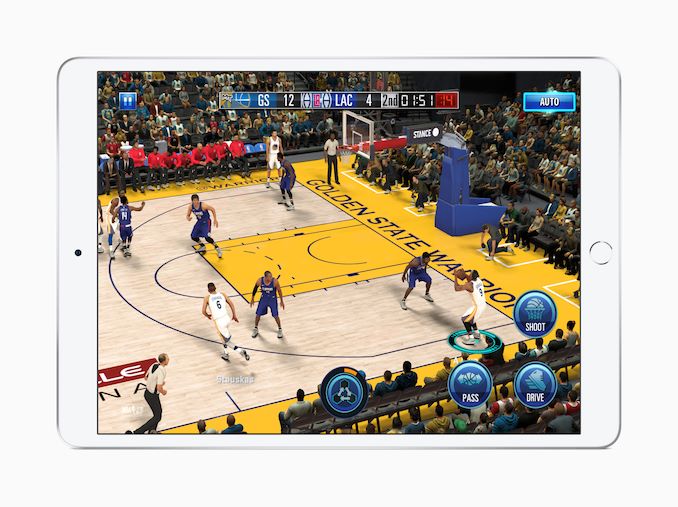Apple Announces New 10.5" iPad Air, 7.9" iPad mini
by Andrei Frumusanu on March 18, 2019 11:30 AM EST
Today in a surprise announcement, Apple has unveiled refreshes to both the iPad Air and iPad mini lineups. The last releases in the lineups were the iPad Air 2 and iPad mini 4 back in 2015. We had thought Apple had abandoned the models, yet today’s release now breathes fresh air into the devices with much needed internal hardware upgrades as well as new functionality.
| Apple iPad Comparison | ||||
| iPad Air 2 | iPad mini 4 | iPad Air (2019) | iPad mini (2019) | |
| SoC | Apple A8X 3 x Typhoon @ 1.5GHz |
Apple A8 2 x Typhoon @ 1.5GHz |
Apple A12 Bionic 2 × Vortex @ 2.5GHz 4 × Tempest @ 1.59GHz |
|
| Display | 9.7" 2048x1536 IPS LCD | 7.9" 2048x1536 IPS LCD | 10.5" 2224x1668 IPS LCD DCI-P3, True Tone |
7.9" 2048x1536 IPS LCD DCI-P3, True Tone |
| Dimensions | 240 x 169.5 x 6.1mm 437g |
203.2 x 134.8 x 6.1mm 298.8g |
250.6 x 174.1 x 6.1mm 456g / 464g |
203.2 x 134.8 x 6.1mm 300g / 308.2g |
| RAM | 2GB LPDDR3 | 2GB LPDDR3 | ? | ? |
| NAND | 16 / 64 / 128GB | 64 / 256GB | ||
| Battery | 27.3Wh | 19.1Wh | 30.2Wh | 19.1Wh |
| Front Camera | 1.2MP, F/2.2 | 7MP, F/2.2 | ||
| Rear Camera | 8MP, F/2.4, 1.1 micron | 8MP, F/2.4 | ||
| Cellular | 2G / 3G / 4G LTE (Category 9) | UE Category 16 LTE (1Gbps) with 4x4 MIMO and LAA | ||
| SIM Size | NanoSIM | NanoSIM + eSIM | ||
| Wireless | 802.11a/b/g/n/ac 2x2 MIMO, BT 4.2 LE, GPS/GLONASS |
802.11a/b/g/n/ac 2x2 MIMO, BT 5.0 LE, GPS/GLONASS |
||
| Connectivity | Apple Lightning 3.5mm headphone |
Apple Lightning 3.5mm headphone |
||
| Launch OS | iOS 9 | iOS 12 | ||
| Launch Price | $499 (16G) $599 (64G) $699 (128G) |
(Wifi / Cellular) $399/$529 (16G) $499/$629 (64G) $599/$729 (128G) |
(Wifi / Cellular) $499/$629 (64G) $649/$779 (256G) |
(Wifi / Cellular) $399/$529 (64G) $549/$679 (256G) |
On the internal hardware side, both the new iPad Air (2019) and the new iPad mini (2019) make use of Apple’s new 7nm A12 chipset, which we’ve already seen in the iPhone XS and XR models. The A12X’s increased performance thus remains exclusive to the iPad Pro models this year.
The new iPad mini doesn’t change its design from its predecessor, which might not be to everybody’s liking in 2019 as the rather big bezels do feel a bit out of place compared to other newer tablets. While the design hasn’t seen an update, the 7.9” 2048x1536 IPS display will see some significant changes as it now supports Display P3 as well as True Tone.
The new iPad Air on the other hand does see significant design changes with a slight reduction in bezels, offering more screen estate. The new display comes now in a 10.5” diameter and increases the resolution to 2224x1668. Similarly to the new iPad mini, it also now supports P3 wide gamut content as well as True Tone.
The new Air is ever so slightly bigger than its predecessor, being 10mm taller, 4.6mm wider and 19g heavier. The new battery does increase from 27.3Wh to 30.2Wh.
Interestingly both devices still come with the home button and its capacitive fingerprint sensor, as well as 3.5mm headphone jack (not that we're complaining), so this is probably Apple’s purest hardware-only refresh ever.
The one single big new feature about the new iPads is that the devices are now compatible with the Apple Pencil. It’s to be noted we’re talking about the first generation Pencil, and not the second-generation unit we find in 2018’s new iPad Pros.
Overall, it’s interesting to see Apple refresh the iPad line-up, especially the often forgotten iPad mini. Apple’s reluctance to make any major design changes to the products, even 4 years on is quite odd, but then again if it isn’t broken, don’t attempt to fix it.
The new iPad mini and iPad Air come in 64 and 256GB variants, starting at $399 for the iPad mini and $499 for the iPad Air. The extra storage costs you $150, and added cellular connectivity adds another $130.
Related Reading
- The Apple iPhone XR Review: A Different Display Leads To Brilliant Battery Life
- The 2018 Apple iPad Pro (11-Inch) Review: Doubling Down On Performance
- The iPhone XS & XS Max Review: Unveiling the Silicon Secrets
- Hands On With the Apple 9.7 Inch iPad Pro
- The Apple iPad Pro Review
- The Apple iPad Mini 4 Review
- The Apple iPad Air 2 Review













74 Comments
View All Comments
osxandwindows - Monday, March 18, 2019 - link
No way I can justify a premium android tablet over this.psychobriggsy - Monday, March 18, 2019 - link
The A12 is a real differentiator versus the mid-range SoCs Android tablets contain. Never mind the lack of extensive tablet optimisation in Android apps. The real question is whether these come with 2GB, 3GB or 4GB of LPDDR4 memory.Roland00Address - Monday, March 18, 2019 - link
*Nods*The Apple iPad Mini is effectively an iPhone XR with the silicon, lets see if it has the 3gb of XR, or the 4gb of the XS and XS max, or if it sticks with 2gb of the previous cheap iPad Mini.
If the new models have 4gb of ram there will be little difference between iPad Air and Mini (2019) vs iPad Pro (2018) for the difference will be A12x vs A12. A12x has a 7 EU GPU vs a 4 EU GPU and has more memory bandwidth, but the CPU is the same with both having a Hexa-core consisting of 2× high performance Vortex cores + 4× high efficiency Tempest cores.
arayoflight - Monday, March 18, 2019 - link
The A12x has an octa-core configuration. 4x Vortex + 4x Tempest. Not to mention higher clock speeds and TDP.DanNeely - Monday, March 18, 2019 - link
I'm seeing reports elsewhere that the 10.5" Pro is being retired to open up the gap between todays releases and the higher end pro models.ksec - Monday, March 18, 2019 - link
Now that you said it, the the Mini is essentially the larger version of XR with Touch ID, inferior camera but better Wireless connection with 1Gbps LTE. And it 64G starts at $529, compared to XR starts at $749That is a whole $220 difference!.
tipoo - Monday, March 18, 2019 - link
I think 2 is safely out, as in the last few years A* chips have matched RAM across iPhones and iPads. So either 3 or 4, and I'd be pretty fine with either, 4 would be a nice bonus.lilo777 - Monday, March 18, 2019 - link
As an owner of Galaxy Tab S2, I disagree with this notion. I use the tablet for web browsing, e-mail and media consumption (YouTube, ESPN, NBA - often just as an interface for ChromeCast). All the apps I uses are either optimized for tablet format or it does not matter (because interface is basically just a way to launch video streaming anyways). I believe this tablet is a better solution than any iPad for most people:* it's thiner and lighter than iPads
* it has more RAM
* it has better screen
* it supports memory cards
The CPU is not super fast but why would it matter for those who, say, does not use their tablets for video editing (and, except for very few use cases, why would people do video editing on a tablet anyways?). Security updates? Samsung tablets get them, Besides have you met a single person who got burned by not getting a timely security update on Android device? I have not.
The only potential advantage iPads offer is 120Hz graphics but, as far as I understand, it's only available on high end (Pro) targeted as "PC replacement" (the goal which they clearly fail at).
jefmes - Monday, March 18, 2019 - link
FWIW as an opposing view point, my wife is considering the new iPad Mini over her current Galaxy Tab S2 because the performance has declined substantially over the past year. No amount of app removal or cleanup seems to help - she gets constant stuttering, and even Chrome will just sit there, pausing for several seconds at seemingly random intervals. Neither of us are fans of the extra Samsung non-removable utilities they force you to have installed, too. She WANTS an updated Nexus 7 more than anything and hates the idea of getting an iPad, but the market doesn't seem interested in selling anything like that any more.lilo777 - Monday, March 18, 2019 - link
I have never experienced slowdowns with Android devices myself but I do see people complaining about it on the Internet from time to time. If this is a wide spread phenomenon I wonder if it was diagnosed. I understand how this might happen when new OS design adds the features that require more CPU/GPU/RAM power but latest versions of Android were not like that (not for a long time). Could it be some rogue apps? They might do more damage on Android than iOS due to the fact that iOS concurrency is crippled by design. Admittedly I do not install that many apps.